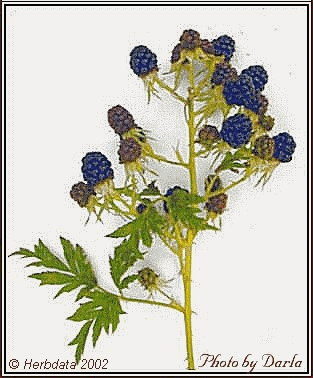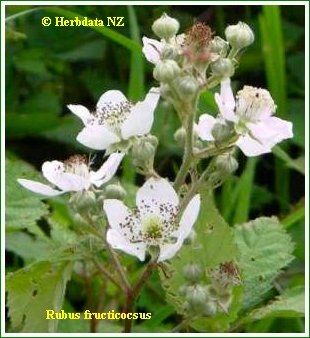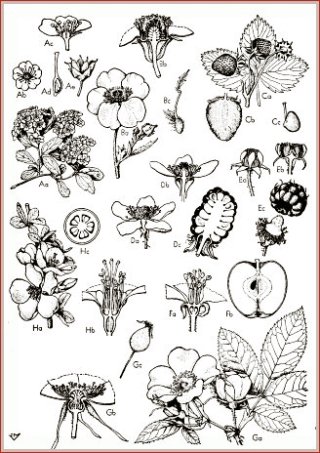
U.S.D. 1926. RUBUS.
N. F. RUBUS [Blackberry Bark]
RUBUS.
N. F. RUBUS [Blackberry Bark]
United States Dispensatory 1926
Mrs. M. Grieve F.R.H.S.
L.H. Bailey Hortorium and Staff Cornell University
Compiled and edited by Ivor Hughes
"Rubus consists of the dried bark of
the rhizome and roots of the section Eubatus Focke of the genus Rubus Linne.
Rubus contains not more than 10 per cent, of adhering wood and not more than
2 per cent, of other foreign organic matter." N. F.
Blackberry Bark; Bramble; Finger Berry; Ecorce deRonce Noir, FT.; Brambeeren, Brombeerrinde, G.
The N. F. IV recognized only, as the source of blackberry root, three species Eubus villosus Ait., R. cuneifolius Pursh. and R. nigrobaccus Bailey; the last named is not recognized by most botanists being considered identical with the R. vollosus. This group of plants is difficult to divide into species because of the occurrence of a great number of intermediate forms. The present edition of the N. F. has not attempted to differentiate between them and has admitted the whole section Eubatus of the genus Rubus. This section would include a very large number of plants most of which, however, do not grow in this country and probably never appear in American drug markets. The species which are of most importance as sources of the drug are described below.
Formerly the N. F. recognized both the root and the fruit, but only the first named is at present official. Rubus villosus Ait. is the common blackberry of North America and is widespread in burned-over woodlands and along roadsides from New England to Florida. It is a shrub attaining a height of 4 to 6 feet and further characterized by possessing imparipinnate leaves with 3 to 5 ovate leaflets with serrate margin and hairy on the ribs of the lower surface. Its young, green branches and pedicels bear numerous glandular hairs while its older branches are straight-prickly, purplish and reclining.
The R. Alleghaniensis Porter, which is found in the
mountainous portions of New England is generally regarded as a variety of
this species. It differs from the type in having narrower leaflets and a
longer, less succulent, fruit.
Rubus canadensis L. (R. procumbetis Muhl.) is an upright or
ascending shrub growing in sandy soil of many sections of the United States
east of the Mississippi river. It attains a height of about 4 feet and
differs from the preceding species chiefly by possessing recurved prickles
and wedge-ovate leaflets which are serrate above middle and white-tomentose
on lower surface.
Rubus villosus Ait. (R. procumbens Muhl.) or dewberry differs from the foregoing species in being low-growing or prostrate in habit. Its stems bear stout recurved prickles and its leaflets are rhombic-obovate with doubly serrate margins. It is a native of open fields of the northern United States, extending from Maine to Virginia and west to Kansas. The commercial supplies of the drug are obtained chiefly from North Carolina, Virginia, Michigan and Illinois.
Description and Physical Properties. � " Unground Rubus. � In elongated, tough, flexible quills or bands, from 3 to 6 mm. in diameter, the bark from 1 to 2 mm. in thickness; outer surface deep red-brown or dark gray-brown, occasionally blackish brown, somewhat scaly; inner surface yellow or pale brown, strongly and coarsely long straight-striate; fracture tough-fibrous; readily splitting. Inodorous; taste strongly astringent and bitter.
"Powdered Rubus. � Dark brown; fibers, long, irregular with thick, lignified walls from 0.010 to 0.045 mm. in width; numerous fragments composed of cortical parenchyma containing either rosettes of calcium oxalate the latter from 0.015 to 0.045 mm. in diameter or numerous simple to many-compound starch grains, the individual grains up to 0.015 mm. in diameter; fragments of cork tissue, the cells with light-brownish walls." N. F.
Its virtues depend chiefly upon tannin, which is an abundant constituent. The woody part of the roots is inert.
The fruit was described by the N. F. IV as " The fresh, ripe fruit of varieties of Rubus nigrobaocus Bailey or Rubus villosus Alton (Fam. Rosaeea). An aggregate fruit, ovate to oblong, rounded or slightly pointed, composed of numerous, shining black drupelets attached to an esculent receptacle; pericarp externally smooth or with only a few hairs (R. villosus), mesocarps fleshy, juice purple-red, endocarps hard, black, surfaces deeply wrinkled." N. F. IV.
Uses. � Dewberry and blackberry roots have long been a favorite domestic astringent remedy in diarrheas. Given in decoction, they are usually acceptable to the stomach, without being offensive to the taste. The decoction may be prepared by boiling an ounce of the smaller roots, or of the bark of the larger, in a pint and a half of water down to a pint, of which from one to two fluidounces (30 to 60 cc.) may be given to an adult three or four times, or more frequently, during the twenty-four hours.
Dose
, from fifteen to thirty grains (1-2 Gm.).Off. Prep. � 'Fluidextractum Kubi, N. F.; Syrupus Eubi, N. F.

Mrs. M. Grieve F.R.H.S.
N.O. Rosaceae
Synonyms. Bramble. Bumble-Kite. Bramble-Kite. Ely. Brummel. Brameberry. Scald-head. Brambleberry
Parts Used. Root, leaves
Habitat. In Australia, the Blackberry grows more luxuriantly than in any other part of the world, though it is common everywhere
The Blackberry, or Bramble, growing in every English hedge-row, is too well known to need description. Its blossoms, as well as its fruits, both green and ripe, may be seen on the bush: at the same time, a somewhat unusual feature, not often met with in other plants.
History. The name of the bush is derived from brambel, or brymbyl, signifying prickly. We read of it as far back as the days
of Jonathan, when he upbraided the men of Shechem for their ingratitude to his father's house, relating to them the parable of the trees choosing a king, the humble bramble being finally elected, after the olive, fig-tree and vine had refused the dignity. The ancient Greeks knew Blackberries well, and considered them a remedy for gout.Opinions differ as to whether there is one true Blackberry with many aberrant forms; or many distinct types. Professor Babington divides the British Rubi into forty-one species, or more.
Rubiis rhamnifolius and R. coryfolius furnish the Blackberries of the hedges, in which the calyx of the fruit is reflexed; R.fructicosus has also a reflexed calyx, but the leaves are hoary underneath. R. ccesius furnishes Dewberries, distinguished by the large size of the grains, which are covered with bloom and few in number, the whole being closely clasped by the calyx. R. saxatilis, the Roebuck-berry, and the badge of the McNabs, is an herbaceous species found in mountainous places in the North, and distinguished by its ternate leaves and fruit of few red large grains. R. chameenorus, the Cloudberry, and badge of the McFarlanes, is also herbaceous, with an erect stem, 6 to 8 inches high, lobed leaves, and a single flower which is succeeded by a large orange-red fruit of an agreeable flavour.
The double-flowering Rubus of gardens is a variety of R. fructicosus. R. lancinatus, of which the native country is unknown, is a rampant species with deeply-cut leaves and large black fruit, which are highly ornamental in autumn.
R. odoratus, the American Bramble, is an erect, unbranched shrub, with large five-lobed leaves and rose-coloured flowers.
R. occidentalis, the Virginian raspberry, has pinnate and ternate leaves, white flowers and black fruit.It is well known that the barren shoots of most of our British Rubi, from being too flexile to keep upright, bend downwards even from the hedges and thickets, and root their ends in the soil, thus following that mode of increase which in the strawberry is effected by the scion. The loop thus formed was formerly an object of occasional search, being reputed in some counties (and we have known it so in Gloucestershire) as capable of curing hernia or rupture when used aright, to which end the afflicted child is passed backwards and forwards through the arching bramble. The origin of this custom is difficult to trace; but quoting from Notes and Queries, the passing of children through holes in the earth, rocks, and trees, once an established rite, is still practised in various parts of Cornwall.
Children affected with hernia are still passed through a slit in an ash sapling before sunrise, fasting; after which the slit portions are bound up, and as they unite so the malady is cured.
It would appear that in Cornwall the bramble-cure is only employed for boils, the sufferer being either dragged or made to crawl beneath the rooted shoot. We have heard of coins that were said to be 'mouse-crope," or to have been walked over by a shrew-mouse (an ancient way of accounting for paralysis), being dragged through the bramble-loop, in which case, if the creature could wait the time of finding a loop large enough, and suffer the dragging process at the end, we should say the case would not be so hopeless as that of our friend's fat pig, who, when she was ailing, 'had a mind to kill her to make sure on her!' (LINDLEY'S Treasury of Botany.)
The Blackberry is known in some parts of the country as 'Scaldhead,' either from producing the eruption known as scaldhead in children who eat the fruit to excess - the over-ripe fruit being indigestible - or from the curative effects of the leaves and berries in this malady of the scalp, or from the remedial effects of the leaves, when applied externally to scalds. The leaves are said to be still in use in England as a remedy for burns and scalds; formerly their operation was helped by a spoken charm. Creeping under a Bramble-bush was itself a charm against rheumatism, boils, blackheads, etc. Blackberries were in olden days supposed to give protection against all 'evil runes," if gathered at the right time of the moon. The whole plant had once a considerable popular reputation both as a medicine and as a charm for various disorders.
The flowers and fruit were from very ancient times used to remedy venomous bites; the young shoots, eaten as a salad, were thought - though Gerard cautiously suggests the addition of a little alum � to fasten loose teeth. Gerard and other herbalists regard the bramble as a valuable astringent, whether eaten or applied: its leaves 'heal the piles that hang out,' and are a most useful application for piles; its fruit stops looseness of the bowels and is good for stone, and for soreness in mouth and throat.
Medicinal Action and Uses. The bark of the root and the leaves contain much tannin, and have long been esteemed as a capital astringent and tonic, proving a valuable remedy for dysentery and diarrhoea, etc. The root is the more astringent.
Preparations. Fluid extract, � to 1 drachm. Fluid extract, root, U.S.P., 15 drops. Syrup, U.S.P., 1 drachm.
The fruit contains malic and citric acids, pectin and albumen. If desiccated in a moderately hot oven and then reduced to a powder, it is a reliable remedy for dysentery.
The root-bark, as used medicinally, should appear in thin tough, flexible bands, inodorous, strongly astringent and somewhat bitter. It should be peeled off the root and dried by artificial heat or in strong sun. One ounce, boiled in i� pint water or milk down to a pint, makes a good decoction. Half a teacupful should be taken every hour or two for diarrhoea. One ounce of the bruised root, likewise boiled in water, may also be used, the dose being larger, however. The same decoction is said to be useful against whooping-cough in the spasmodic stage. The leaves are .also employed for the same purpose. One ounce of the dried leaves, infused in one pint of boiling water, and the infusion taken cold, a teacupful at a time, makes a serviceable remedy for dysentery, etc.
RECIPES
Blackberry jelly
has been used with good effects in cases of dropsy caused by feeble, ineffective circulation, and the London Pharmacopoeia (1696) declared the ripe berries of the bramble to be a great cordial, and to contain a notable restorative spirit. Blackberry wine is made by crushing the fruit and adding one quart of boiling water to each gallon of the fruit, allowing to stand for 24 hours, stirring occasionally, and then straining off the liquid, a Ib. of white sugar are then added to every gallon, and it is kept in a tightly corked cask till the following October. This makes a trustworthy cordial astringent, used in looseness of the bowels. Another delicious cordial is made from pressing out the juice from the ripe Blackberries, adding 2 Ib. of sugar to each quart and \ oz. of nutmegs and cloves. Boil all together for a short time, allow to get cold and then add a little brandy.In Crusoe's Treasury of Easy Medicines (1771) a decoction of Blackberry leaves is recommended as a fomentation for longstanding ulcers. There is also a popular country notion that the young shoots, eaten as a salad, will fasten loose teeth. A noted hair-dye has been made by boiling the leaves in strong lye, which imparts to the hair a permanent soft black colour.
Blackberry Vinegar is a wholesome drink that is easily made and can with advantage have its place in the store cupboard for use in winter, being a fine cordial for a feverish cold.
Gather the berries on a fine day, stalk them, put into an earthenware
vessel and cover with malt vinegar. Let them stand three days to draw out
the juice. Strain through a sieve, drain thoroughly, leaving them to drip
through all day. Measure the juice and allow a pound of sugar to each pint.
Put into a preserving pan, boil gently for 5 minutes, removing scum as it
rises, set aside to cool, and when cold, bottle and cork well. A teaspoonful
of this, mixed with water, will often quench thirst when other beverages
fail and makes a delicious drink in fever.

11th Revised Edition
ROSACE�. ROSE FAMILY
the typical rose fl. looks like a typical buttercup fl. but it is perigynous (ovaries inferior or in the hypanthium), has a disk, and the stamens are in whorls or cycles; from the saxifrage family it is known by its numerous stamens in cycles, carpels usually more numerous, seeds mostly not albuminous.
Herbs, shrubs, small trees, spiny or unarmed, sometimes climbing, largely of temp, regions: Ivs. usually alternate and stipular, but the stipules sometimes caducous: fls. mostly bisexual and regular, in many colors, but white, pink, and rose predominating, the envelopes borne on the edges (perigynous) of a hypanthium (calyx-tube) that is lined or rimmed with a glandular disk; sepals or calyx-lobes 4r-5, and petals of same number or seldom wanting; stamens commonly numerous (but sometimes definite), in whorls or cycles of 5, perigynous; pistils 1 to many and when solitary the carpels 1�5 (or many), ovaries 1- to several-ovuled, placentation basal, axile or parietal, the styles as many as the carpels: fr. various, sometimes an achene, sometimes a follicle, hip, pome, or drupe; seeds usually exalbuminous.
The receptacle or hypanthium assumes various forms: in the rose it is hollow and bears the pistils (which become achenes) on the inside, forming a hip; in the strawberry it is much enlarged and fleshy, forming the "berry"' on the outside of which the achenes or true frs. (usually called "seeds") are borne; in the raspberry it is the cone that remains on the bush when the cluster of drupelets is picked; in the blackberry it is the core to which the drupelets adhere; in the apple and pear (which are pomes) it is the fleshy part of the fr. outside the core. In the plum tribes the ovary is superior and forms a drupe without attachment of hypanthium. Many of the species in this family run into numberless cultivars.
====================
If you did not find what you were seeking then use the site search box located at the top right hand of the page or else return to the main site library index.
![]()